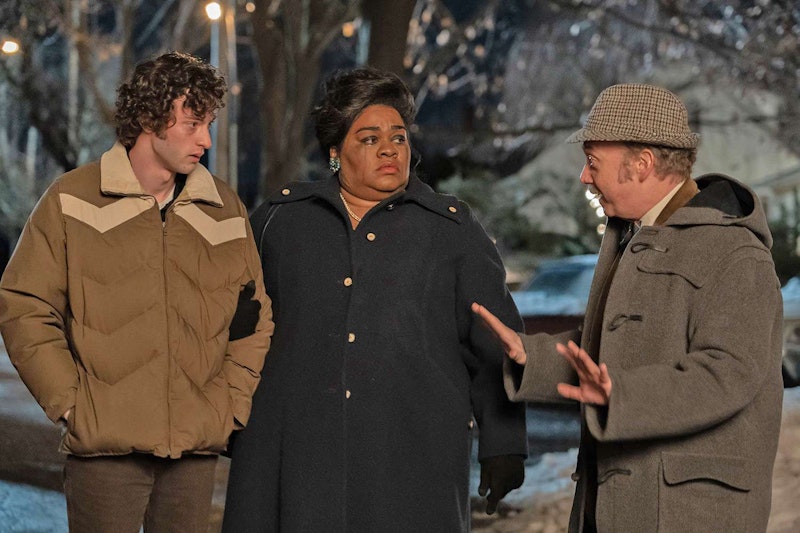Six years is a long time in between movies. Not much of that is idle time, if any, for a director—assuming they want to keep making movies at certain level. Alexander Payne has returned to winter theaters after 2017’s bloated Downsizing, which was much better than most said—like Adam McKay’s Don’t Look Up, it was hopeless and full of desperate, jealous, selfish people, and both movies were heavily criticized because people knew these situations would play out exactly like this in real life: Kristen Wiig would have second thoughts and leave her husband Matt Damon shrunken, and the world would probably behave like they did during Don’t Look Up if faced with an actual asteroid headed towards Earth.
The difference is I don’t think McKay succeeded in combining so many tones, whereas all Payne was doing was transposing his usual snide, misanthropic view onto a bigger story with science fiction elements and toys. Like Suburbicon, another Matt Damon movie from 2017, Downsizing was way too bitter and dark to take, and both films were poorly advertised from the start. It’s important to remember what Stanley Kubrick told Albert Brooks in 1981 when the head of Columbia told him that he had to add “a psychiatrist scene” to Modern Romance to explain his character’s borderline sociopathic behavior: “The studios decide what’s a hit and what isn’t. There’s nothing you can do about it.” What that means is fewer screens, fewer ads, fewer promotional appearances.
And the world didn’t hear much from Payne in the last six years, besides a categorical denial that he tried to seduce an underage Rose McGowan by whipping out his dick. That was three years after Downsizing, but only a year before principal photography on his latest film began. The Holdovers begins with three glorious retro bumpers: the blue MPAA RATED R, and imagined retro intros for Focus Features and Miramax. All of this, along with the beginning and end of the movie, have a considerable amount of fake film grain added, and while I understand everyone calling this a cheap trick in an otherwise much deeper movie, the execution is superb and I had no problem with it (A24’s bumper, for example, has a much less interesting and convincing grain structure). So this is another Gen X director looking back at his childhood in late-middle age, another movie like Once Upon a Time in Hollywood, Licorice Pizza, and Armageddon Time (Steven Spielberg even jumped into the trend with The Fabelmans, a film he’d had since the 1990s but was too scared to make).
Payne grew up in Omaha, and he didn’t go to boarding school, but he went to a coat-and-tie prep school with architecture and halls just like those of The Holdover’s fictional Barton Academy. Paul Giamatti plays the irascible Classics teacher, already a fossil in 1970; Dominic Sessa plays the main student, an actor in his film debut mostly performing in the actual high school where he’d graduate six months after filming finished; Da’Vine Joy Randolph is the cook who lost a son in Vietnam last year, and they’re all “holding over” at the school during Christmas vacation while everyone else spends the holidays with their families.
I don’t often use character names when writing about movies, because all you’re seeing and all you’ll remember are the actors—it’s a real accomplishment when you can create real characters with living actors. Paul Hunham is just as real to me as Paul Giamatti; I’ve never met neither, but I know them from the screen. Sessa should have a brilliant career after this entrance—if he doesn’t, Angus Tully will be the name people remember. Mary Lamb is the first fully realized character that Randolph has been able to play, and I want both of them to win the Oscar for Best Supporting Actor.
The Holdovers reminded most of James L. Brooks, whose films are full of stock characters, greeting card platitudes, and Hallmark schmaltz—but, somehow, he’s able to imbue that material with a warmth and a substance that elevates it into something ecstatic and nearly spiritual, realizing the promise of every false advertisement and every toy that said, “I love you.” He was more than Capra, he was true love; The Holdovers contains little romantic intrigue, but in the 133 minutes we spend with these three people, we get to know them. That almost never happens at the movies. Unlike the above—save Once Upon a Time in Hollywood—this will become the Christmas classic it wants to be. Giamatti deserves the Best Actor Oscar even though it’ll go to the equally deserving Cillian Murphy, who’ll win for all the usual reasons: biopic, accent, forced starvation. In any case, they’ll always be linked by that trailer that ran before Oppenheimer, the first time we met Paul, Angus, and Mary.
Like Once Upon a Time in Hollywood, there’s no director stand-in, and that’s what’ll make the film endure: its characters. Rick Dalton is enough of a “name” that Quentin Tarantino was able to successfully announce his “death” earlier this year and hold a memorial—ditto for his stuntman Cliff Booth. Tracy Flick from Election is another eternal character, along with most of the people in that movie; but this is the first time Payne has hit a nerve in over 20 years. His supreme achievement, 2002’s About Schmidt, is a rare movie about mediocrity, one where the lead, Jack Nicholson, doesn’t rise to the occasion in the end, and remains as pathetic and scared as he was at the beginning. That filmed was feted, but it was a different era—because Paul (Giamatti, Hunham) redeems himself in the end by falling on his sword, it makes the movie a lot less painful than the rest of Payne’s work. Unlike his other movies, these people really love each other.
—Follow Nicky Smith on Twitter: @nickyotissmith

